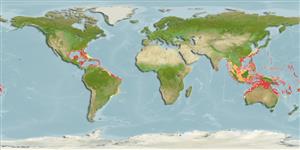Iotrochota birotulata (Hinggin, 1877)
Green finger sponge| Native range | All suitable habitat | Point map | Year 2050 |

|
| This map was computer-generated and has not yet been reviewed. |
| Iotrochota birotulata AquaMaps Data sources: GBIF OBIS |
Upload your photos
Google image |
No photo available for this species.No drawings available for Iotrochotidae.
Google image |
No photo available for this species.
Classification / Names Common names | Synonyms | CoL | ITIS | WoRMS
Demospongiae | Poecilosclerida | Iotrochotidae
Environment: milieu / climate zone / depth range / distribution range Ecology
Sessile; brackish; depth range 1 - 91 m (Ref. 108813). Tropical
Distribution Countries | FAO areas | Ecosystems | Occurrences | Introductions
Indo-Pacific and Western Atlantic: Caribbean wide.
Length at first maturity / Size / Weight / Age
Maturity: Lm ? range ? - ? cm Max length : 60.0 cm TL male/unsexed; (Ref. 415)
Short description Morphology
Sprawling ramose branches, with spiky surface up to 60 cm long; 1 - 5 cm wide. Black with green patches internally and externally. Oscula 0.1 - 0.3 cm in diameter, on side of branches (Ref. 415). Smaller specimens grows as lobes, runners, massive or encrusting. Surface: covered with conules; mostly or entirely smooth for small specimens. Sometimes greenish-yellow. Tough consistency; resilient and barely compressible. Exudate is dark purplish when squeezed. Oscules are scattered or in a row, slightly raised on small lobes and surrounded by a thin collar (Ref. 85482).
Reef; mangrove; seagrass environments (Ref. 415). On hard substrates, often hosting the zoanthid Parazoanthus swiftii (Ref. 85482). Commensal with amphipods (Ref. 82302).
Life cycle and mating behavior Maturity | Reproduction | Spawning | Eggs | Fecundity | Larvae
Members of the class Demospongiae are hermaphroditic. Life cycle: The zygote develops into parenchymella larva (free-swimming) before settling down on a substrate where it grows into a young sponge.
Main reference
References | Coordinator | Collaborators
Collin, R., M.C. Díaz, J. Norenburg, R.M. Rocha, J.A. Sánchez, M. Schulze, A. Schwartz and A. Valdés. 2005. (Ref. 415)
IUCN Red List Status (Ref. 130435)
CITES status (Ref. 108899)
Not Evaluated
CMS (Ref. 116361)
Not Evaluated
Threat to humans
Harmless
Human uses
| FishSource |
Tools
More information
Internet sources
BHL | BOLD Systems | CISTI | DiscoverLife | FAO(Publication : search) | Fishipedia | GenBank (genome, nucleotide) | GloBI | Gomexsi | Google Books | Google Scholar | Google | PubMed | Tree of Life | Wikipedia (Go, Search) | Zoological Record
Estimates based on models
Preferred temperature
(Ref. 115969): 23.9 - 28.9, mean 27.5 (based on 1216 cells).
Price category
(Ref. 80766):
Unknown.


